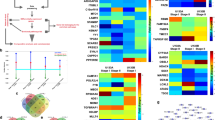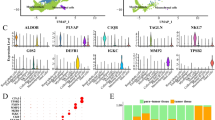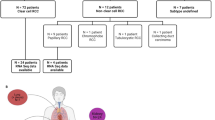Abstract
In this age of targeted therapy, identification of molecular pathways that are deregulated in cancer will not only elucidate underlying tumorigenic mechanisms, but may also help to determine the classes of drugs that are used for treatment. In kidney cancer, a spectrum of histological subtypes exists that are characterized both by distinct molecular signatures and increasingly by distinct molecular pathways that are deregulated in each subtype. For example, the VHL/hypoxia pathway is well-known to be deregulated in clear cell renal cell carcinoma (RCC) whereas in papillary RCC activation of the HGF/Met pathway has been implicated. Additional molecular pathways, many not yet identified, may also be involved in the development of the different histologic subtypes. Moreover, differences in pathway activation may reflect differences in tumor progression and response to treatment. In this article, we describe an oncogenomic approach, based on integrative analysis of gene expression profiling data. In this approach, gene expression data is used to identify both cytogenetic abnormalities and molecular pathways that are deregulated in RCC. Ideally, predicted pathway abnormalities can be linked to predicted cytogenetic abnormalities to identify likely candidate genes. Although further cellular and functional studies are warranted to validate the computational models, development of such models in RCC have the potential to open up new avenues of molecular research and may have significant diagnostic and therapeutic implications.
This is a preview of subscription content, access via your institution
Access options
Subscribe to this journal
Receive 50 print issues and online access
$259.00 per year
only $5.18 per issue
Buy this article
- Purchase on Springer Link
- Instant access to full article PDF
Prices may be subject to local taxes which are calculated during checkout

Similar content being viewed by others
References
Adler AS, Lin M, Horlings H, Nuyten DS, van de Vijver MJ, Chang HY . (2006). Genetic regulators of large-scale transcriptional signatures in cancer. Nat Genet 38: 421–430.
Bild AH, Yao G, Chang JT, Wang Q, Potti A, Chasse D et al. (2005). Oncogenic pathway signatures in human cancers as a guide to targeted therapies. Nature 439: 353–357.
Chi JT, Wang Z, Nuyten DS, Rodriguez EH, Schaner ME, Salim A et al. (2006). Gene Expression Programs in Response to Hypoxia: cell type specificity and prognostic significance in human cancers. PLoS Med 3: e47.
Cohen HT, McGovern FJ . (2005). Renal-cell carcinoma. N Engl J Med 353: 2477–2490.
Crawley JJ, Furge KA . (2002). Identification of frequent cytogenetic aberrations in hepatocellular carcinoma using gene expression data. Genome Biol 3: RESEARCH0075.
Desai KV, Xiao N, Wang W, Gangi L, Greene J, Powell JI et al. (2002). Initiating oncogenic event determines gene-expression patterns of human breast cancer models. Proc Natl Acad Sci USA 99: 6967–6972.
Dupont J, Khan J, Qu BH, Metzler P, Helman L, LeRoith D . (2001). Insulin and IGF-1 induce different patterns of gene expression in mouse fibroblast NIH-3T3 cells: identification by cDNA microarray analysis. Endocrinology 142: 4969–4975.
Ferrando AA, Neuberg DS, Staunton J, Loh ML, Huard C, Raimondi SC et al. (2002). Gene expression signatures define novel oncogenic pathways in T cell acute lymphoblastic leukemia. Cancer Cell 1: 75–87.
Furge KA, Lucas KA, Takahashi M, Sugimura J, Kort EJ, Kanayama HO et al. (2004). Robust classification of renal cell carcinoma based on gene expression data and predicted cytogenetic profiles. Cancer Res 64: 4117–4121.
Gerritsen ME, Tomlinson JE, Zlot C, Ziman M, Hwang S . (2003). Using gene expression profiling to identify the molecular basis of the synergistic actions of hepatocyte growth factor and vascular endothelial growth factor in human endothelial cells. Br J Pharmacol 140: 595–610.
Harding MA, Arden KC, Gildea JJ, Perlman EJ, Viars C, Theodorescu D . (2002). Functional genomic comparison of lineage-related human bladder cancer cell lines with differing tumorigenic and metastatic potentials by spectral karyotyping, comparative genomic hybridization, and a novel method of positional expression profiling. Cancer Res 62: 6981–6989.
Huang E, Ishida S, Pittman J, Dressman H, Bild A, Kloos M et al. (2003). Gene expression phenotypic models that predict the activity of oncogenic pathways. Nat Genet 34: 226–230.
Hughes TR, Roberts CJ, Dai H, Jones AR, Meyer MR, Slade D et al. (2000). Widespread aneuploidy revealed by DNA microarray expression profiling. Nat Genet 25: 333–337.
Kim S, Volsky DJ . (2005). PAGE: parametric analysis of gene set enrichment. BMC Bioinformatics 6: 144.
Lamb J, Crawford ED, Peck D, Modell JW, Blat IC, Wrobel MJ et al. (2006). The connectivity map: using gene-expression signatures to connect small molecules, genes, and disease. Science 313: 1929–1935.
Phillips JL, Hayward SW, Wang Y, Vasselli J, Pavlovich C, Padilla-Nash H et al. (2001). The consequences of chromosomal aneuploidy on gene expression profiles in a cell line model for prostate carcinogenesis. Cancer Res 61: 8143–8149.
Staller P, Sulitkova J, Lisztwan J, Moch H, Oakeley EJ, Krek W . (2003). Chemokine receptor CXCR4 downregulated by von Hippel–Lindau tumour suppressor pVHL. Nature 425: 307–311.
Subramanian A, Tamayo P, Mootha VK, Mukherjee S, Ebert BL, Gillette MA et al. (2005). Gene set enrichment analysis: a knowledge-based approach for interpreting genome-wide expression profiles. Proc Natl Acad Sci USA 102: 15545–15550.
Sweet-Cordero A, Mukherjee S, Subramanian A, You H, Roix JJ, Ladd-Acosta C et al. (2005). An oncogenic KRAS2 expression signature identified by cross-species gene-expression analysis. Nat Genet 37: 48–55.
Tomlinson IP, Alam NA, Rowan AJ, Barclay E, Jaeger EE, Kelsell D et al. (2002). Germline mutations in FH predispose to dominantly inherited uterine fibroids, skin leiomyomata and papillary renal cell cancer. Nat Genet 30: 406–410.
Vanharanta S, Pollard PJ, Lehtonen HJ, Laiho P, Sjoberg J, Leminen A et al. (2006). Distinct expression profile in fumarate-hydratase-deficient uterine fibroids. Hum Mol Genet 15: 97–103.
Virtaneva K, Wright FA, Tanner SM, Yuan B, Lemon WJ, Caligiuri MA et al. (2001). Expression profiling reveals fundamental biological differences in acute myeloid leukemia with isolated trisomy 8 and normal cytogenetics. Proc Natl Acad Sci USA 98: 1124–1129.
Xu XR, Huang J, Xu ZG, Qian BZ, Zhu ZD, Yan Q et al. (2001). Insight into hepatocellular carcinogenesis at transcriptome level by comparing gene expression profiles of hepatocellular carcinoma with those of corresponding noncancerous liver. Proc Natl Acad Sci USA 98: 15089–15094.
Acknowledgements
This work was supported by NIH Grant R33-CA10113-01 to KAF and the Van Andel Research Institute. We acknowledge The Gerber Foundation, Hauenstein Foundation, Fischer Family Trust, the Michigan Economic Development Corporation and the Michigan Technology Tri-Corridor, the Schregardus Family Foundation, and Amway Japan Limited. We thank the Cooperative Human Tissue Network of the National Cancer Institute for providing tumor samples for this research. We also thank Sabrina Noyes for administrative support.
Author information
Authors and Affiliations
Corresponding authors
Rights and permissions
About this article
Cite this article
Furge, K., Tan, M., Dykema, K. et al. Identification of deregulated oncogenic pathways in renal cell carcinoma: an integrated oncogenomic approach based on gene expression profiling. Oncogene 26, 1346–1350 (2007). https://doi.org/10.1038/sj.onc.1210256
Published:
Issue Date:
DOI: https://doi.org/10.1038/sj.onc.1210256
Keywords
This article is cited by
-
Renal Cell Carcinoma: Molecular Aspects
Indian Journal of Clinical Biochemistry (2018)
-
Renal Cell Carcinoma Deep Sequencing: Recent Developments
Current Oncology Reports (2012)
-
Comparative gene expression profiling analysis of urothelial carcinoma of the renal pelvis and bladder
BMC Medical Genomics (2010)



